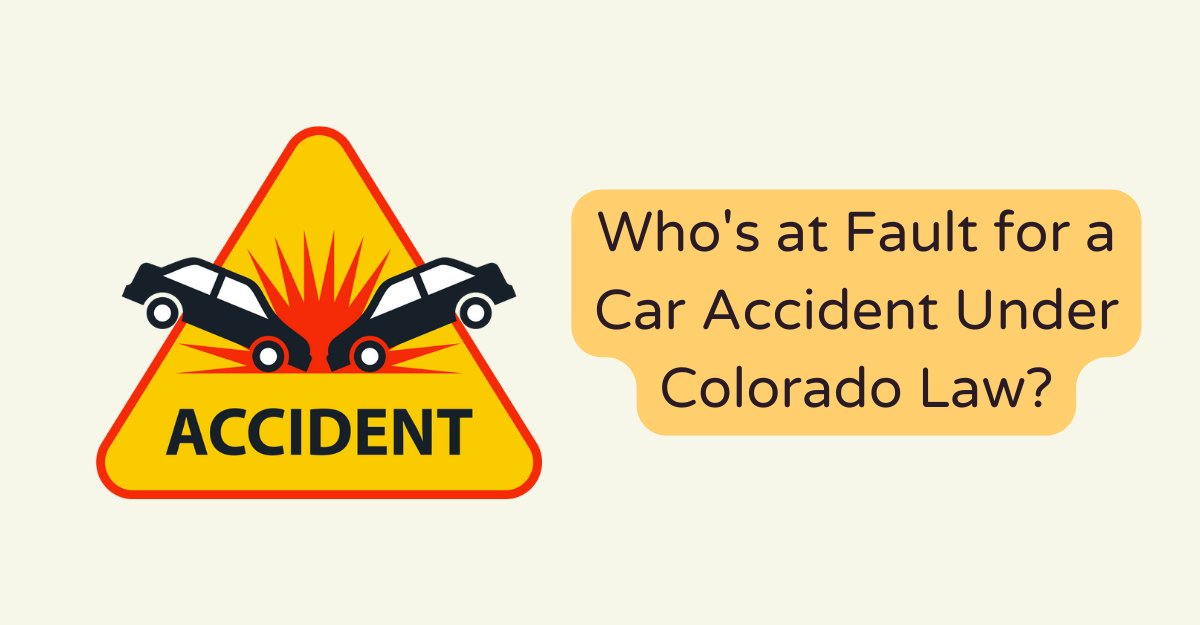
Who’s at Fault for a Car Accident Under Colorado Law?
Navigating the aftermath of a car accident can be a daunting task, especially when determining fault under Colorado law. Understanding the legal landscape is crucial for anyone involved in such an incident. The state’s unique approach to negligence and liability can significantly impact the outcome of a case. In this article, we’ll delve into the key aspects of determining fault in Colorado car accidents, exploring how these laws affect your rights and options. Our goal is to provide clarity and guidance in these complex situations.
Understanding Negligence in Colorado Car Accidents
In Colorado, negligence plays a crucial role in determining fault in car accidents. Negligence refers to a failure to act with the level of care that a reasonable person would in similar circumstances. To prove negligence, four elements must be established: duty, breach, causation, and damages. A personal injury lawyer in Colorado can help victims navigate this legal process. For instance, a driver who runs a red light and causes a collision has breached their duty to obey traffic laws, leading to an accident. The victim must then show that this breach directly caused their injuries and resulted in quantifiable damages. Colorado’s “modified comparative negligence” rule adds complexity, allowing for shared fault between parties. Understanding these legal nuances is essential for anyone involved in a car accident in the state.
Comparative Fault: Sharing the Blame
Colorado employs a “modified comparative fault” system, which can significantly impact the outcome of a car accident claim. Under this rule, each party’s level of fault is assessed, and damages are allocated accordingly. For example, if a driver is found to be 30% at fault for an accident, their recoverable damages will be reduced by that percentage. However, there’s a catch: if a party is found to be 50% or more at fault, they are barred from recovering any damages. This system emphasizes the importance of thorough accident investigations and evidence collection. It also highlights the need for clear communication with insurance companies, as they play a key role in the fault determination process. Navigating this aspect of Colorado law requires a keen understanding of how fault is calculated and its implications on a case’s outcome.
The Role of Evidence in Determining Fault
In Colorado car accident cases, evidence is the cornerstone of establishing fault. The types of evidence that can be crucial include police reports, witness statements, photographs of the accident scene, and surveillance footage. These pieces of evidence provide objective accounts of the events leading up to and during the accident. For instance, a police report may document traffic violations or signs of impaired driving, which are significant indicators of negligence. Witness statements can offer different perspectives on the accident, shedding light on details that may not be immediately apparent. Additionally, advancements in technology, such as dashcams and traffic cameras, have become invaluable in capturing real-time footage of accidents. The compilation and analysis of this evidence are vital in piecing together the sequence of events and determining the responsible party.
Legal Time Limits: Understanding the Statute of Limitations
In Colorado, the statute of limitations for car accident claims is a critical aspect to consider. Generally, victims have three years from the date of the accident to file a lawsuit for property damage. However, for personal injury claims, the time limit is reduced to two years. Missing this deadline can result in the loss of the right to seek legal recourse. It’s essential to be aware of these time constraints to ensure your case is filed timely. Consulting with a legal professional can help you navigate these deadlines effectively.
Insurance Considerations in Colorado Accidents
In the aftermath of a car accident in Colorado, insurance plays a pivotal role in the financial aspect of recovery. Colorado is a “fault” state, meaning the driver at fault for the accident is responsible for covering the damages. This is typically handled through their insurance company. Drivers are required to carry minimum liability insurance, which includes coverage for bodily injury and property damage. However, it’s advisable to have more than the minimum coverage, as costs can quickly exceed these limits. Uninsured/underinsured motorist coverage is also crucial, as it protects you if the at-fault driver lacks sufficient insurance. Navigating insurance claims can be complex, with negotiations and settlements often involved. It’s important to understand your policy and rights to ensure you receive fair compensation for your losses.
Navigating Fault and Seeking Justice in Colorado Car Accidents
Navigating the complexities of fault in Colorado car accidents requires a thorough understanding of the law. Whether you’re dealing with insurance claims or legal proceedings, knowledge is power. Remember, the outcome of your case can hinge on the details of the accident and the evidence available. Seeking professional advice can be invaluable in protecting your rights and interests. Ultimately, a fair resolution is the goal, ensuring that justice is served for all parties involved.